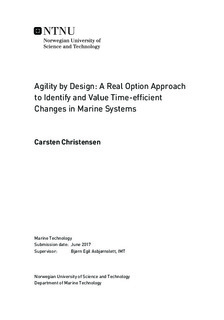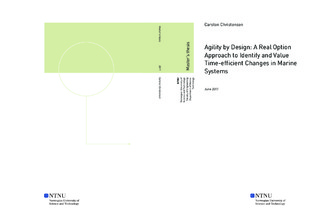| dc.description.abstract | Quickly adapting to changing market conditions is crucial for every firm, especially in volatile and capital intensive markets. These are two characteristics of the maritime industry. Incorporating flexibility in design have gathered an increased focus as means to cope with such a dynamic context. To be flexible is not always enough, partially because exploiting this flexibility causes a time delay. This time delay causes more uncertainty, which could make a good investment decision into a bad one. Hence, this master thesis investigates the contribution from investment lags in engineering systems by the following: (i) Structuring and presenting a real option framework for identification of possible design solutions that reduces investment lag (ii) Propose value models for system design changes that are exposed for investment lag (iii) Propose design solutions that limits the investment lag. For this, an elongation of a dry bulk vessel is a thorough example.
Agility represents the ability of a system to change quickly, and investment lag is the time from the decision is made until the system has changed capabilities. All investments have lags to some degree, which is often disregarded in traditional real options analyses. For systems with relatively long time lags, there is a need to better understand the impact of these investment lags. To identify design solutions that enables agility, a further separation in the real options framework has been proposed as a contribution to the existing literature. On options is seen as the superior option, which is the operational option on a projects future cash flow. This is often related to changes in value enabling variables, and as this is the conventional real option, there exist an established valuation framework for it. Further, on options are separated in two classes, Built-in-Design options and Design Change options. The former is multifunctionality that are implemented in the system from the initial design stage, the latter are options that make changes in the design, often referred to as in options, which comes with an investment lag due to off-hire when performing the design change.
By this separation of on options, path enablers could be tied to real options.
Path enablers are features that enables easier change in value enabling variables, making it easier to exercise options. Design path enablers are design features that enables easier exercise of design change option, thereby reducing the investment lag and cost of exercise. Thus, Design Change options could be seen as operational path enablers, that enables change of operation, which by definition is an on options.
The relation between the option value of a capacity expansion/market entry, and the investment lag is defined to value agility. This gives a possible value for investment lag reducing path enablers. A design neutral capacity expansion in the dry bulk freight market is used as an illustrative case, and by introducing the investment lag as a parameter in the real option model, the value of a capacity expansion option could be considered as a function of investment lag. For this, the cost of investment lag is defined as the opportunity cost of operating in the market.
The analysis is conducted in several steps, by three models with increasing degree of complexity. Qualitative and quantitative time series analysis on dry bulk freight rates in the Capesize segment in the time span between 1990 and 2017 resulted in freight market replications for two of the models using the geometric Mean Reversion model, and the last with market rates and asset prices as correlated mean reversion paths. Then, by Monte Carlo simulation, a now-or-never investment analysis determines the value of agility by simulation of the projects cash flows, thereafter through including investment timing flexibility based on the Least Squares Monte Carlo algorithm, which gives the value of agility through an established option valuation framework. For this model two approaches were taken, one with correlated vessel values and freight rates, and one with vessel values as a value of underlying freight rates.
The option value reflects a premium of second hand vessel prices with different investment lags, and with no investment lag the maximum value will be respectively 147, 60 and 12.2 USD/dwt for the now-or-never approach, LSMC and LSMC and with correlated asset paths, which is reduced to 85 %, 65% and 55% of maximum value for an investment lag of 6 months. The results of the different models are quite consistent in their form, and the spread between the maximum value can be explained through different approaches and different underlying stochastic processes. The LSMC model with vessel values as function of freight rates is seen as the most realistic, as it includes investment timing flexibility and geometric Mean Reversion as underlying stochastic process for freight market dynamics.
Further, design path enablers for the illustrative case is proposed, an elongation of a dry bulk carrier which gives a capacity expansion. Design path enablers for this elongation is elements that make the vessel ready for elongation, examples of this can be thickness of plates and visibility. As the design still water bending moment and wave bending moment is a function of L^3, a greater thickness is required. Further, the visibility of water surface shall not be obscured by more than 1xLOA forward of the bow. Hence, path enablers for an elongation from 150m to 200m could be to build the initially 150m long vessel with bottom plate thickness of 12mm instead of the required 11mm and a higher bridge. This will make the initial structure ready for 200m LOA.
By implementing design path enablers one increases the design freedom over the systems lifetime. In conventional design thinking, a design is often optimised for a base case. Though, by implementing design path enablers, one admit that the future is uncertain and partly unpredictable, and enables easier future design changes. This will increase the design freedom over the systems lifetime, which again is reflected by flexibility in operations at a strategic level. By implementing such design path enablers, together with Built-in design options, agility is enabled through design, thus, Agility by Design. | |

